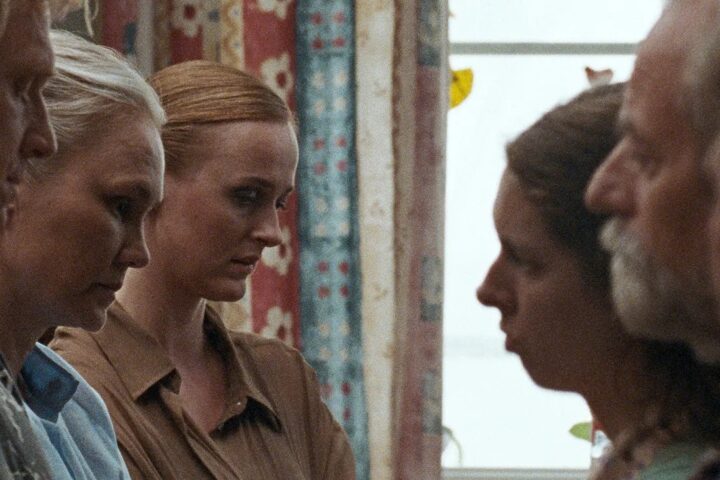A loving yet tough-minded documentary about the legacy of Sly Stone, Questlove’s Sly Lives! (aka the Burden of Black Genius) has more on its mind than charting the rise and fall of another troubled icon. As its title suggests, the film wants to use Stone’s life and career as a jumping-off point for a larger examination of the double standards often levied by society against Black artists deemed “geniuses.” While Sly Lives! makes a strong argument for raising the question, it never fully grapples with the answer. Ultimately, though, it’s on firmer ground when painting a picture of its subject’s specific and one-of-a-kind genius.
Questlove’s rendering of Stone’s inspiring and tragic story is as vibrant and pulse-pounding as could be hoped for. An East Bay-raised music prodigy who could play almost every instrument and was arranging and performing in his family’s church at an early age, Stone broke into the Bay Area music scene in the mid-1960s just as it was opening up to more experimentation. It was perfect timing for a nascent artist whose tastes crossed genres (a popular radio DJ, he played a wide range of rock and R&B) and whose mind was overflowing with ideas.
Stone made his name as a producer whose youth belied his skill for midwifing greatness; still sounding awed today, Grace Slick describes how he turned “Somebody to Love” from an idea into a song. He moved from producing to performing in 1966 with Sly and the Family Stone, which included several of his siblings. The band not only blew minds with their proto-funk sound, balancing complex polyrhythms with foot-stomping grooves, but made a statement with the novelty of having male, female, Black, and white performers all in the same group.
The concert and recording footage Questlove weaves through the first half of Sly Lives! show a group of performers hitting peak after peak. There’s a spectacularly pulsating energy to the film as it follows the seemingly unstoppable nature of Stone’s rocketing arc. Band members recall how after their 1967 debut, A Whole New Thing, stiffed on the charts and they were told by Clive Davis to deliver a hit single, Stone answered the challenge with the still-electrifying proto-disco smash “Dance to the Music.” After that, the upward swing commenced, from a triumphant Woodstock performance to multiple chart-toppers through the early ’70s.
The film mixes some context to its story of success by illustrating how revolutionary it was for a band with a swinging R&B song led by a Black frontman to tour with rock bands and get played on pop radio. Like in Summer of Soul, Questlove displays a historian’s curiosity for lost moments from the cultural past which help make Sly Lives! as rewarding as it is.
Questlove lines up a bevy of talking heads to provide homage to a groundbreaker. Interviewees point to everything from P-Funk to Prince being impossible without Stone’s innovations. Musicians like Q-Tip and Vernon Reid, innovators themselves, speak to Stone’s unpredictable genius and broad influence. But Questlove also shows that he has a better sense than some music documentarians for when effusive yet shallow praise becomes repetitive.
Producers like Jimmy Jam and Terry Lewis express admiration for Stone’s musicianship but also discuss him as a kindred spirit, another expert practitioner in the art of assembling music. Jam and Lewis’s closely observed breakdown of specific songs builds the film’s argument that Stone wasn’t just a songwriting and performing powerhouse but a technician who could layer and arrange songs with a complexity that was attention-grabbing rather than off-putting.
As Sly Lives! pivots toward the long years of chaos and decay that followed Stone’s spiraling drug addiction starting in the mid-to-late ’70s, the focus turns from the fruits of genius to how it can also be a trap. D’Angelo talks in highly vulnerable terms about the expectations demanded of Black artists, as does the clearly Stone-indebted Andre 3000.
Questlove never quite gets to an answer to the questions he throws out to the gathered artists about the burden of Black genius, and maybe never intended to. But Sly Lives! pays appropriate credit to its subject’s greatness by not devolving into pity even after depicting Stone at his lowest points. In one of the film’s most pointed clips, Questlove shows Stone saying to an interviewer well after the high point of his career, “We deserve everything we get.” Sly Lives! doesn’t judge Stone, but it also gives him the credit of not making excuses.
Since 2001, we've brought you uncompromising, candid takes on the world of film, music, television, video games, theater, and more. Independently owned and operated publications like Slant have been hit hard in recent years, but we’re committed to keeping our content free and accessible—meaning no paywalls or fees.
If you like what we do, please consider subscribing to our Patreon or making a donation.



